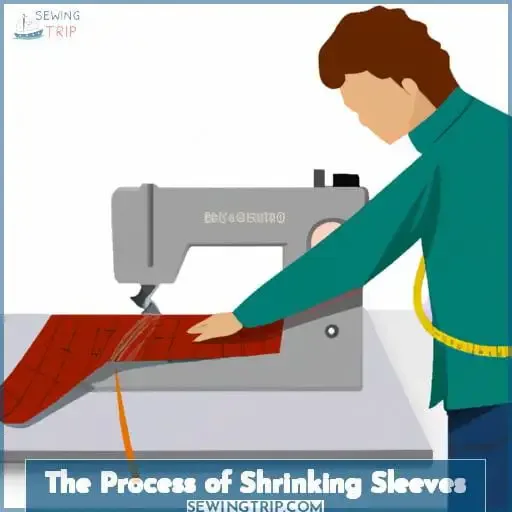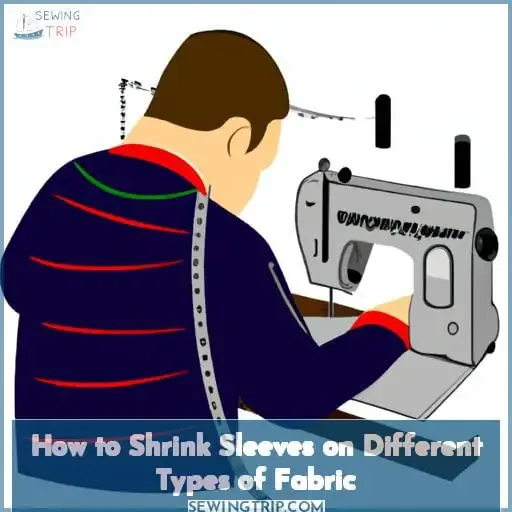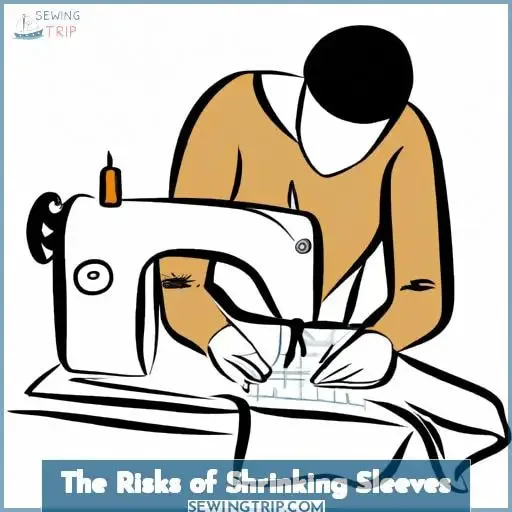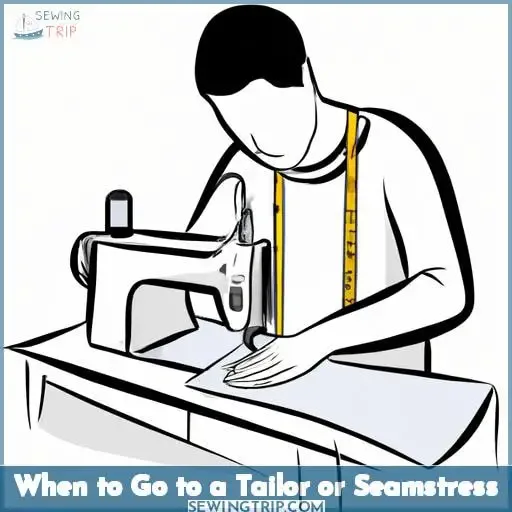This site is supported by our readers. We may earn a commission, at no cost to you, if you purchase through links.
Have you ever been in the situation where your favorite shirt just doesn’t fit right? Maybe it’s too big or its sleeves are a bit long. Don’t worry, there’s something you can do to fix this! You can shrink those sleeves and make your shirt look perfect again. Shrinking clothing can seem intimidating, but it doesn’t have to be complicated. All you need is some knowledge of the fabric and an understanding of how heat affects different materials.
In this article, we’ll go through what kind of fabrics shrink best and which techniques work on different types. By the end, you’ll know exactly how to get those pesky sleeve lengths down without damaging them!
Table Of Contents
Understanding the Fabric
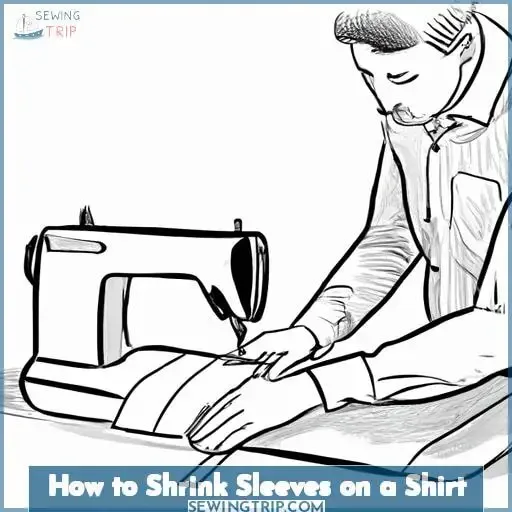
When it comes to shrinking shirt sleeves, understanding the fabric is key. Different types of fabrics respond differently to heat and moisture, so you’ll need to know which kind of fabric your shirt contains before you begin.
Cotton tends to shrink the most when exposed to high temperatures or boiling water, while polyester and nylon require more extreme methods, like ironing, for effective results.
Types of Fabric
Knowing the type of fabric in your shirt is key to determining the best way to alter its sleeves. Natural fibers like cotton or wool shrink easily, while synthetic fabrics such as polyester and nylon don’t. Blends require a combination of techniques depending on the materials used. Consider safety when using heat-based methods; use an iron set to low levels and a pressing cloth with delicate items like silk or linen garments. Tailoring costs vary depending on fabric selection, so it pays off to research which approach will work best for the material before attempting any DIY alterations.
Which Kind of Fabric Shrinks the Most?
You may already know that natural fibers such as cotton and wool shrink more easily than synthetic fabrics like polyester or nylon. But there are other factors to consider when attempting to shrink a shirt sleeve, including selecting the right fabric for the job, understanding stretching behaviors of different materials over time, and choosing appropriate shrinking alternatives.
For example, if you’re looking for dramatic reshaping of sleeves on a cotton garment then boiling water is one option; however handwashing with warm water is often enough to achieve some degree of shrinking in most cases. Ironing technique can also be employed but it’s important not only select an appropriately hot setting based on your fabric type u2014 pay attention too whether you have pre-shrunk material u2014 but also use a pressing cloth when tackling any garment containing polyester fibers as they will melt otherwise!
With these tips at hand (pun intended!), now all that remains is mastering your own craftsmanship so that no matter which route you take – from boiling water down through air/sunlight drying – the results always reflect who’s wearing them: You!
The Process of Shrinking Sleeves
Shrinking shirt sleeves is a great way to get the perfect fit. The easiest way is through using the dryer. But if that’s not available, washing and air drying can be used. You can also try ironing or boiling water with polyester shirts. All of these methods require different techniques to get optimal results without over-shrinking.
The Easiest Way to Shrink Sleeves on a Shirt
The easiest way to give your shirt a new look is by running it through a hot water cycle in the dryer. Before beginning, make sure you know the exact sleeve measurements and fabric type of the garment.
Select cotton or other natural fibers for successful shrinking; synthetic fabrics like polyester may require boiling water or an ironing method. Set accurate heat levels: lower for delicate fabrics, higher for thicker materials like denim or wool.
If using an iron, ensure its temperature matches the fabric’s specs. Avoid any moisture-based stretching techniques at all costs! Monitor progress regularly until desired results have been achieved.
With careful selection and precise methods, you can shrink sleeves without overdoing it.
How to Shrink Sleeves on a Shirt Without a Dryer
Stretch out fabric before wetting. Wet material with hot or cold water. Iron fabric while damp to reshape fibers. Steam materials for polyester garments. Use hot cycle in a washing machine or send them for professional dry cleaning.
Shrinking sleeves on a shirt without a dryer is possible. Boiling water and an iron can help tailor it to your desired shape. Follow these steps and you’ll learn how to shrink sleeves without drying equipment!
How to Shrink Sleeves on a Shirt Without Washing
If you want to tailor the sleeves on your shirt without washing it, an iron and boiling water can help. Heat-shrinking is the most effective way for getting one-size-fits all shirts tailored to fit. Use steam or boiling water to dampen fabric, then use an iron appropriate for your fabric type to press seams or hems that need hemming.
Polyester requires higher temperatures before it becomes malleable; cotton shrinks quickly when exposed to heat, even if prewashed. But be careful – boiling water can cause too much shrinkage and you’ll be right back where you started!
How to Shrink Sleeves on a Shirt With the Ironing Method
You can easily tailor your shirt’s sleeves with an iron and some steam to get the perfect fit! Stretching techniques, sewing techniques, ironing temperatures and heat settings are all important factors. Consider the fabric of the garment too, as plant fibers will react differently than synthetic materials. Cotton or linen should only be exposed to very hot water, while polyester may need boiling water. Normal size shirts usually require long thread strains for proper tailoring, but smaller sizes may not need them due to dye blending that adds stretchiness when needed.
How to Shrink Sleeves on a Shirt With Boiling Water
If you need a more dramatic sleeve alteration, boiling water may be the answer! This method carries a higher risk of over-shrinking than other methods. Fill a pot with enough water to submerge your shirt in and bring it to a boil on high heat. Once boiled, turn off the heat and carefully add your shirt into the pot. Ensure it’s fully submerged for 30 minutes, stirring occasionally with tongs or spoon handle (be careful not to burn yourself!).
Remove the shirt using tongs or gloves and squeeze out excess moisture. Place it onto an ironing board covered by pressing cloth to protect against fabric damage caused by direct contact between iron heating surface and polyester content fabrics. Polyester fabrics are prone to melting due to their low melting point temperatures.
Set the iron to the appropriate heat setting depending on the fabric being used. Work quickly but gently across all areas where the sleeve needs shrinking until the desired size reduction is achieved without causing any harm such as stretching or distortion.
Air dry naturally, avoiding exposure to sunlight, drying, or machine dryer cycles. These can cause additional shrinkage control issues and potential color fading if garments don’t have preshrunk treatment applied beforehand.
For best results, consider tailor advice or alteration tips before attempting DIY alterations. This is especially true when dealing with natural fibers such as cotton, wool, silk, or linen blends, as they require specialized handling techniques. Synthetic materials such as polyester and nylon tend to respond better to extreme temperature changes.
Take proper care throughout the process, avoiding harsh chemicals found in many detergents, bleach, and chlorine-based products. Abstain from using fabric softeners, as this is likely to affect how much shrinkage occurs. Boiling water is the easiest way to achieve the desired outcome efficiently.
How to Shrink Sleeves on Different Types of Fabric
Shrinking sleeves on a shirt can be done in several ways, depending on the type of fabric.
For cotton shirts, ironing or boiling water is fastest.
When working with wool garments, avoid extreme temperatures. Use warm water and moderate heat to shrink them slowly.
Polyester requires high heat exposure to shrink. It’s best to use an iron or hairdryer for targeted shrinking, as boiling polyester may damage its fibers.
How to Shrink Sleeves on Cotton Shirts
If you need to give your cotton shirt a new fit, try shrinking the sleeves for an easy and effective alteration. While most types of fabric can be shrunk using basic laundering methods, cotton shirts require special attention due to their tendency to shrink more easily than other fabrics.
Patch seams before washing to reduce fraying and ensure desired results. Choose dyes that won’t run or bleed in hot water if altering color is part of the plan.
Measure arms first so you know what size sleeve will fit after shrinking. Consider laundering tips as different types of fabric may require extreme settings for maximum effect, but beware – this could be risky business!
With these simple methods in mind, you’ll have no trouble giving your cotton shirt a professional-looking makeover without breaking any buttons or spending too much time at it.
How to Shrink Sleeves on Wool Garments
If you’re looking to update a wool garment, try altering the sleeves for a contemporary fit without damaging the fabric. Wool is an all-natural material that shrinks easily and needs special care when it comes to shrinking techniques.
When selecting fabric for your shirt, keep in mind that different kinds of fabrics shrink differently due to unique molecular and chemical structures – natural materials such as wool may contract or expand quite easily while synthetic materials like polyester require boiling water to shrink significantly.
If you’re worried about over-shrinking or damaging your piece of clothing, consider seeking professional assistance from a tailor or sewist who can help with sleeve alteration.
Professional tailors are also better equipped at handling Dri Fit shirts which shouldn’t be exposed to high heat to adjust their size; instead buy them in desired size since they can’t be shrunk using any method whatsoever!
How to Shrink Sleeves on Polyester Garments
Transform your polyester garments with a few simple steps to give them the perfect fit! Find the right heat setting for your garment; use an iron or steamer that matches the fabric weave and never exceed this temperature. Consider special treatments like chemical dyeing or stitching techniques that may impact the shrinking process. Heat, moisture, and friction can all make clothing shrink – so use a pressing cloth when using extreme temperatures like boiling water. Don’t forget about color-safe products: if you’re worried about fading colors, opt for color-safe detergents instead of regular laundry detergent.
The Risks of Shrinking Sleeves
When altering your shirt’s sleeves, it is important to be aware of the risks involved in order to ensure you achieve the desired result. Shrinking a shirt sleeve can lead to wrong sizing if not done properly, so understanding shrinking techniques and fabric selection are key. Heat application should also be considered; extreme temperatures can cause dramatic reshaping but may damage fabrics that can’t withstand high levels of heat, like polyester or delicate materials such as wool, silk, or linen.
Here are some tips for minimizing the risk associated with shrinking a shirt sleeve:
- Use low heat settings on any equipment used and always check frequently;
- Consider using specialized treatments such as boiling water for polyester or steaming instead of ironing delicate fabrics;
- Utilize pressing cloths whenever possible and look out for pre-shrunk fabric options;
- Try running through one cycle on hot setting in dryer before checking results, then repeating process if necessary;
- Always follow manufacturer instructions included in garments carefully.
When to Go to a Tailor or Seamstress
If you’re looking for a professional finish on your shirt sleeves, consider consulting a tailor or seamstress. A skilled seamstress can adjust the length of sleeves using stretching and sewing techniques. They’ll also be able to ensure the fabric weight is suitable for shrinking without damaging it.
Tailors have access to specialized equipment, making them better equipped than most people at home attempting DIY alterations. This increases their success rate and ensures quality results quickly and efficiently without any disasters.
Iron temperature when shrinking sleeve lengths must be controlled to achieve an accurate shrinkage rate and avoid over-shrinking and wrinkles in the fabric.
Frequently Asked Questions (FAQs)
How much will the sleeves shrink?
Shrinking sleeves on a shirt isn’t an exact science, so it’s important to understand the degree of shrinkage you can expect. Cotton shirts generally have higher levels of sleeve elasticity than polyester shirts, so they may only slightly reduce in size when exposed to heat. Polyester garments, however, don’t stretch easily without losing shape permanently, so more dramatic shrinking should be expected. Washing temperature and overdrying fabric are factors, but the type of fabric and its elasticity determine how much your shirt’s sleeves will shrink.
Is it possible to shrink only one sleeve?
Yes, it’s possible to shrink just one sleeve of a shirt. But it carries risks. If you do it yourself, pay close attention; it can cause an overall decrease in size and shape of the garment if not done carefully with consideration for fabric choice and sleeve shape. Shrinking one side could affect how well it fits. So tailored options may cost more upfront, but could save time and money down the line.
Are there any risks to using extreme heat to shrink a shirt?
Shrinking a shirt with extreme heat can be a double-edged sword. On one hand, it may give you the perfect fit you’re looking for; however, on the other hand, there are risks. Chemicals from the fabric can leach out and cause colour fading or make your garment shrink resistant. Iron burning is also possible if too high of temperatures are used while ironing or boiling water. It’s important to use caution and understand shrinking isn’t an exact science, so proceed carefully!
What is the best way to prevent wrinkles while shrinking a shirt?
To prevent wrinkles while shrinking a shirt, pre-shrink the fabric by steam treating or hand washing in hot water. You can also apply a shrink proofing product before laundering. Another option is using a clothing steamer for wrinkle removal and sleeve reduction. For garments containing delicate fabrics such as wool, silk or linen, avoid extreme heat and use cold water instead to reduce size without causing damage. However, this won’t be as effective for shrink proofing these materials. Waterproofing products are another great way to protect clothes from wrinkles due to heat-based shrinking processes.
Are there any fabrics that should not be shrunk in the washing machine or dryer?
When it comes to shrinking fabrics, not all materials can be shrunk in the washing machine or dryer. All-natural fibers like cotton and wool are sensitive to heat and may shrink when exposed to extreme temperatures. Synthetic fabrics like polyester usually need boiling water or high ironing temps for significant shrinking.
Pay attention to care labels on garments; some fabric blends shouldn’t be subjected to even moderate heat due to dye leaching, stretching of delicate fibers, or overall shape loss caused by intense temperature changes.
Choosing the right fabric for your garment is essential if you want successful shrinkage results!
Conclusion
Conclusion: Shrinking shirt sleeves is an easy way to customize your wardrobe. With the right tools and techniques, you can achieve the perfect fit, no matter the fabric.
However, it’s important to remember that extreme methods like boiling water and ironing can cause damage to certain fabrics. So, it’s important to assess the fabric type before attempting to shrink the sleeves.
Are you willing to take the risk? With the right care and attention, you can shrink those sleeves without a problem.

